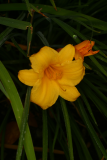Additional notes (click to expand)
Medicinal
'The roots of Hemerocallis species (day lilies) ingested by goats, sheep and cattle, and used for the treatment of schisotosomiasis in humans, have caused fatalities in the People's Republic of China'. Active principle is hemerocallin (stypandrol),
Jian-Hua Wang et al. (1989) Structure and Distribution of a neurotoxic principle, hemerocallin Phytochemistry (1989) 28(7):1825-1826
In traditional medicine, The flower of the related species H. fulva is said to deaden pain, given in childbirth. The root of the same species has a folk history of use in the treatment of cancer - extracts from the roots have shown antitumour activity.
Duke, J. A. & Ayensu, E. S., 1985. Medicinal Plants of China. Vol. 2, Reference Publications, Inc. Michigan p.400
Phytochemistry
see ref (in full under toxicity)
Jian-Hua Wang et al. (1989) Structure and Distribution of a neurotoxic principle, hemerocallin
Toxicity
Hemerocallis species have caused fatalities in the People's Republic of China, when taken for treating schistosomiasis. Active principle of H. thunbergii isolated from the roots, is hemerocallin, which has the same structure, clinical and pathological effects as stypandrol (from Stypendra imbriciata - called Blind Grass - producing mydriasis, progressive and irreversible blindness and paralysis. Hemerocallis esculenta, H. altissima, H. lilio-asphodelus and H. minor are also toxic. The same chemical is found in the leaves of Dianella revoluta (blue-flax lily).
Jian-Hua Wang et al. (1989) Structure and Distribution of a neurotoxic principle, hemerocallin Phytochemistry (1989) 28(7):1825-1826
The flower of the related species H. fulva has been used in traditional medicine to deaden pain in childbirth and the root of the same species has a folk history of use in the treatment of cancer - extracts from the roots have shown antitumour activity.
Medicinal plants of China p.400
Hemerocallis 'Stella de Oro'
Family: ASPHODELACEAEGenus: Hemerocallis
Species:
Cultivar: 'Stella de Oro'
Common names: Daylily
Distribution summary: Garden Origin
Habit: Perennial
Hardiness: H5 - Hardy; cold winter
Garden status: Currently grown
Garden location: Far East (L)
Flowering months: May, June, July
.JPG)
.JPG)

.JPG)
.JPG)

.JPG)